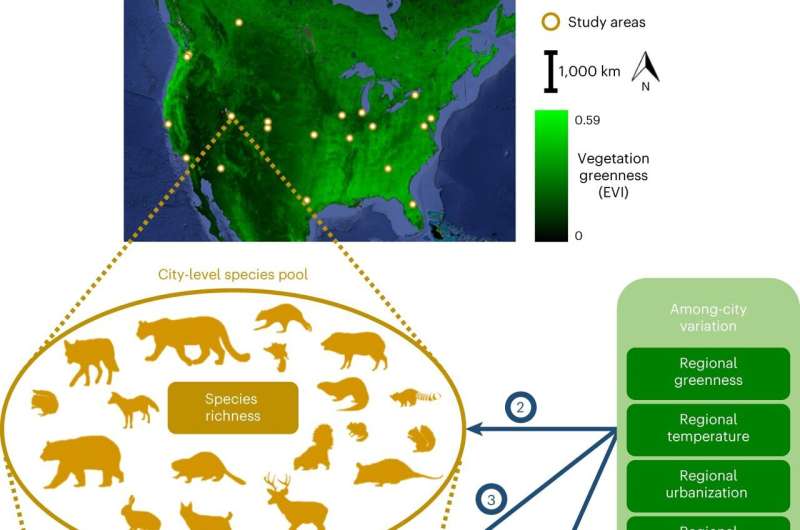September 6, 2023 report
This article has been reviewed according to Science X's and . have highlighted the following attributes while ensuring the content's credibility:
fact-checked
peer-reviewed publication
trusted source
proofread
Finding the balance between urbanization, climate change and wildlife conservation

Research led by Arizona State University, Tempe, has looked into how urbanization, species traits and environmental factors interact to shape urban wildlife communities. This research is essential for effective conservation in the face of urban expansion and climate change.
In a paper, "Urbanization, climate and species traits shape mammal communities from local to continental scales," published in Nature Ecology & Evolution, the researchers utilized data from 725 camera-trap sites in 20 North American cities and multi-species occupancy modeling to assess the effects of ecoregional characteristics and species traits on the urbanization-diversity relationship. A News & Views article on the research has been published in the same issue.
The study finds that urbanization, along with human-driven climate change, negatively impacts wildlife communities at local scales, reducing species occupancy, richness, and diversity. The impact of urbanization varies among cities but is heavily influenced by regional environmental characteristics, with warmer, less vegetated cities experiencing more severe declines in wildlife diversity.
Mammal identification in camera-trap photos was conducted by trained personnel, including students, faculty, volunteers, and wildlife professionals. While mid-to-large-sized mammal species were well represented, smaller-bodied species were under-represented or not detected at all, which is a typical limitation of camera trapping.
In cities, regional environmental variables substantially influenced local species occupancy and community composition more than the broader regional species richness. Vegetation greenness, temperature, and surrounding urbanization influenced average wildlife occupancy with more negative responses in warmer, less vegetated cities.
Species traits, particularly body size, were seen to play a crucial role in mediating the effects of urbanization on wildlife, although being a carnivore, omnivore, or vegetarian did not have a significant influence.
While it may not be surprising that urbanization generally reduces animal populations, the study suggests that conservation strategies should consider the combined effects of urbanization and climate change on native wildlife communities. The effects could be mitigated by providing resources and habitats for larger-bodied species, especially in currently urbanizing environments where habitat is being converted or incorporated into an urbanized setting.
The findings emphasize the need for flexible and context-specific conservation approaches that take into account the unique characteristics of each urban environment and the species inhabiting them.
More information: Jeffrey D. Haight et al, Urbanization, climate and species traits shape mammal communities from local to continental scales, Nature Ecology & Evolution (2023).
Jiajia Liu, Warming amplifies urbanization effects on mammals, Nature Ecology & Evolution (2023).
Journal information: Nature Ecology & Evolution
© 2023 Science X Network




















